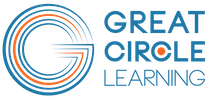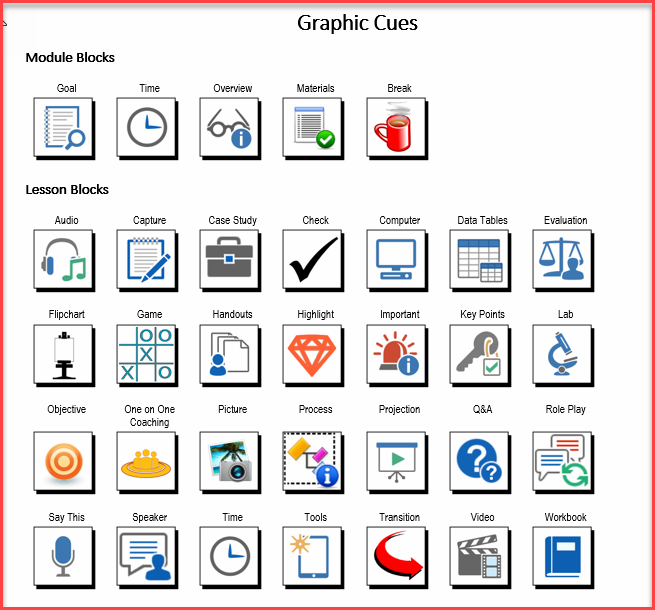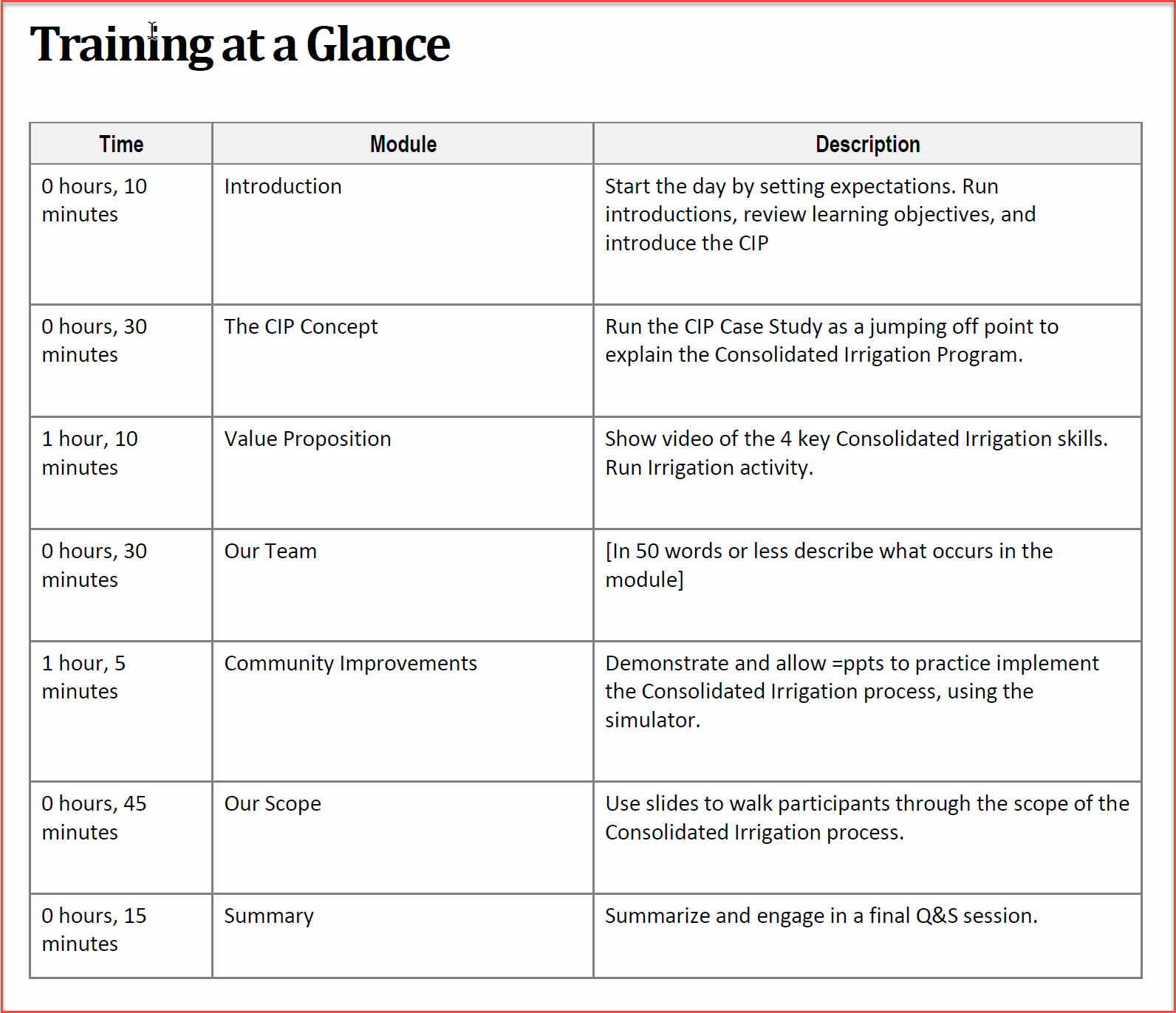Key Components of a Facilitator Guide
As we discussed in our introduction to Facilitator Guides post, a facilitator guides serves two purposes:
A Study Guide for facilitators and producers to prepare to lead the course.
A Delivery Guide for facilitators and producers to stay on topic and on time during the live delivery.
Whether your class is being delivered virtually or in a traditional classroom setting, we must strive to ensure consistency across our training deliveries. With that goal in mind …
Here are the key components of a well-constructed facilitator guide.
1. Table of Contents
A well-constructed facilitator guide should start with a Table of Contents.
Not only does the Table of Contents tell us how to get to the key sections of our guidebook, it displays the structural foundation of our training program and serves as an advance organizer for our facilitator and producer.
2. Instructor Preparation Section
This is the study section of the facilitator guide. It should contain everything the facilitator and producer need to know in order to prepare to deliver the class. Organizing all of this important information at the front of your facilitator guide makes it easier for your instructors and producers to get ready, and it helps ensure consistent delivery of you training every time the class is run. Here are the sections I like to include in this portion of the facilitator guide.
About this Guide
A facilitator guide should be designed in a way that any facilitator can pick up the book and lead the given training. The About this Guide section lays out how the guide is organized and what the facilitator can expect to find in the guidebook.
Visual Cues
If you, like me, want your facilitator’s eyes on the class, then we need to minimize the need to read during the live delivery. We can help accomplish this with visual cues that allow us to convey delivery guidance quickly, because images are processed differently in our brains than words.
Providing visual cues that prompt the facilitator to Say, Do, Ask, etc. ensures that the delivery section of the facilitator guide is an in-the-moment job aide. We can strengthen our visual cues with brief verbal headlines to create an at-a-glance prompting system that makes it easy for the facilitator to stay on track and focus on the participants.
To ensure that our facilitators understand our visual cue system, we must include a cheat sheet reference to all the possible visual cues the instructor may see.
And, of course, then we must use the cues consistently within the delivery section of the facilitator guide.
Seldom would we use every visual cue, but consistently displaying all of them in the study section of our facilitator guides helps our instructors get used to seeing them.
Program in Perspective
Think of this as the 50,000-foot view of the course. In this section, we are answering these questions:
Why is this course being run? The “why” is important on so many levels, and it can be different depending on the audience. For the facilitator, explaining why will help ensure buy-in and build support for complete and consistent delivery of the class.
What are the Learning Objectives? It is important to list the terminal objectives of the training program in the study section of the facilitator guide. The objectives help set everyone’s expectations for the outcome of the training.
What is the Program Timing? Part of helping the facilitator prepare for delivery is clearly stating the time required to deliver the class. From start to finish, including breaks, list how long it will take to deliver.
How many Participants? List the minimum, optimum, and maximum number of participants this class can handle. This number will vary from one class to another, based on the delivery method (in-person vs. virtual) and the activities like role plays, case studies, Q and A sessions, and other instructional elements.
Program Preparation
Here we list the nuts and bolts of what the facilitator needs to do to successfully deliver the program. Items to cover include:
Pre-Work - List the reading, activities, and any prior courses participants need to complete prior to attending this training program. Also note who is to distribute and collect/verify the pre-work.
Required Materials - The laundry list of every item needed to lead this this training program. We keep this master list to make sure everything is on hand before the program begins.
Room Set-Up/Technical Requirements - Detail how to layout the physical or virtual classroom to accommodate the activities and teaching methods employed during the training. For virtual training, this may include making sure polls, breakout rooms and pods are loaded correctly.
Instructor Preparation - Describe what the facilitator must accomplish prior to leading the training.
Training at a Glance
The Training at a Glance is a high-level overview of the course that serves as an advance organizer for the class delivery framework.
The Training at a Glance should include the name of each key instructional chunk, a.k.a. module, the time needed to complete each module, and a brief description of what the facilitator and participants are to accomplish in each module.
We don’t tie the Training at a Glance to a specific day and time because then it would have to be adjusted each time we run the course. This is where an Agenda comes into play, the Agenda being a more detailed and time-specific outline of the class.
3. The Delivery Section
This section is the heart and soul of your facilitator guide. Here we find step-by-step guidance for the class delivery from start to finish. This section includes three key parts: Modules, Lessons, and Content Blocks.
Modules
I refer to the main topics/instructional chunks of my training program as Modules, and my Modules are tied to my terminal objectives.
The Modules serve as a containers for each topic/instructional chunk.
Each Module consists of a Module Overview page that is followed by the Lessons necessary to teach the module.
The Module Overview page serves to signal the start of a new content topic, allowing the facilitator to make a clear transition from the previous topic. It also summarizes what the facilitator needs to do, for how long, and with what materials and equipment. Thus, in addition to the name of the module, the Module Overview page should include:
Module Goal: The terminal objective that is being taught during this chunk of the training.
Time Required: How much time is needed to deliver this module.
Module Overview: The teaching process that the facilitator will follow to lead the participants to the goal of the module.
Module Materials: The list of materials needed to run just this chunk of the training program.
Lessons
I refer to the subtopics within my Modules as Lessons and I tie the Lessons to the Enabling Objectives associated with my Module’s Terminal Objective.
Each new Lesson should begin with a goal that states the enabling objective, and the time allotted to deliver this portion of the Module.
The Lesson pages should then consist of the content necessary to guide the live delivery of the class.
Content Blocks
I refer to the visual cues, headlines, and specific content for each trainer action as Content Blocks.
Content Blocks clearly and concisely describe exactly what the facilitator and producer need to do in the moment.
Are these all the parts needed in a facilitator guide?
They are not. We also need a cover page, an acknowledgements/legal notice page, and more - depending on the class. The key components listed above set the foundation so that a course can be delivered consistently each and every time.
But there’s more… If you have not had a chance to read our primer for facilitator guides, you should. And my next posts will cover:
Strategies for Developing Facilitator Guides
Differences of Facilitator Guides for Virtual and Physical Classroom
Does this seem like a lot of work?
We have a tool that will help you. It sets up a base facilitator guide that contains all of these key parts and it automates your work as you add content.






